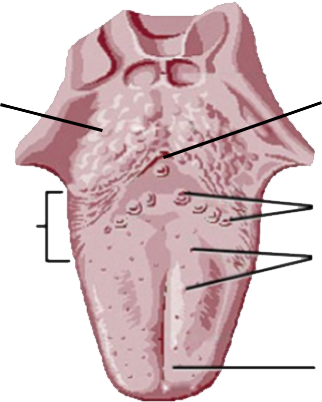Difference between revisions of "AY Honors/Taste/Answer Key/es"
From Pathfinder Wiki
(Created page with "</noinclude> <!-- 1. ¿Qué es el sistema gustativo? -->") |
(Updating to match new version of source page) |
||
| (9 intermediate revisions by 2 users not shown) | |||
| Line 1: | Line 1: | ||
{{HonorSubpage}} | {{HonorSubpage}} | ||
| − | <section begin="Body" /> | + | <section begin="Body" /> |
{{ansreq|page={{#titleparts:{{PAGENAME}}|2|1}}|num=1}} | {{ansreq|page={{#titleparts:{{PAGENAME}}|2|1}}|num=1}} | ||
<noinclude></noinclude> | <noinclude></noinclude> | ||
<!-- 1. ¿Qué es el sistema gustativo? --> | <!-- 1. ¿Qué es el sistema gustativo? --> | ||
| − | + | {{clear}} | |
| − | |||
| − | |||
<noinclude></noinclude> | <noinclude></noinclude> | ||
{{CloseReq}} <!-- 1 --> | {{CloseReq}} <!-- 1 --> | ||
{{ansreq|page={{#titleparts:{{PAGENAME}}|2|1}}|num=2}} | {{ansreq|page={{#titleparts:{{PAGENAME}}|2|1}}|num=2}} | ||
| − | <noinclude> | + | <noinclude></noinclude> |
| − | </noinclude> | + | <!-- 2. Definir la palabra «gusto». --> |
| − | <!-- 2. | ||
| − | |||
| − | |||
<noinclude></noinclude> | <noinclude></noinclude> | ||
{{CloseReq}} <!-- 2 --> | {{CloseReq}} <!-- 2 --> | ||
{{ansreq|page={{#titleparts:{{PAGENAME}}|2|1}}|num=3}} | {{ansreq|page={{#titleparts:{{PAGENAME}}|2|1}}|num=3}} | ||
| − | <noinclude> | + | <noinclude></noinclude> |
| − | </noinclude> | + | <!-- 3. ¿Qué son las papilas gustativas? --> |
| − | <!-- 3. | ||
| − | |||
| − | |||
| − | + | {{clear}} | |
| − | |||
| − | |||
| − | + | {{clear}} | |
| − | |||
| − | |||
| − | |||
| − | + | [[File:Taste buds.svg|thumb|Papilas gustativas]] | |
| − | [[File:Taste buds.svg|thumb| | ||
| − | |||
<noinclude></noinclude> | <noinclude></noinclude> | ||
{{CloseReq}} <!-- 3 --> | {{CloseReq}} <!-- 3 --> | ||
{{ansreq|page={{#titleparts:{{PAGENAME}}|2|1}}|num=4}} | {{ansreq|page={{#titleparts:{{PAGENAME}}|2|1}}|num=4}} | ||
| − | <noinclude> | + | <noinclude></noinclude> |
| − | </noinclude> | + | <!-- 4. Nombrar las cinco sensaciones gustativas. --> |
| − | <!-- 4. | ||
| − | |||
| − | |||
| − | |||
| − | |||
| − | |||
| − | |||
| − | + | {{clear}} | |
| − | |||
| − | |||
| − | |||
| − | |||
| − | |||
| − | |||
| − | + | {{clear}} | |
| − | |||
| − | |||
| − | + | {{clear}} | |
| − | |||
| − | |||
<noinclude></noinclude> | <noinclude></noinclude> | ||
{{CloseReq}} <!-- 4 --> | {{CloseReq}} <!-- 4 --> | ||
{{ansreq|page={{#titleparts:{{PAGENAME}}|2|1}}|num=5}} | {{ansreq|page={{#titleparts:{{PAGENAME}}|2|1}}|num=5}} | ||
| − | <noinclude> | + | <noinclude></noinclude> |
| − | </noinclude> | + | <!-- 5. En el siguiente diagrama, identificar las partes indicadas del sistema gustativo. --> |
| − | <!-- 5. | ||
| − | |||
| − | + | {{clear}} | |
| − | |||
| − | |||
| − | |||
| − | |||
| − | |||
<noinclude></noinclude> | <noinclude></noinclude> | ||
{{CloseReq}} <!-- 5 --> | {{CloseReq}} <!-- 5 --> | ||
{{ansreq|page={{#titleparts:{{PAGENAME}}|2|1}}|num=6}} | {{ansreq|page={{#titleparts:{{PAGENAME}}|2|1}}|num=6}} | ||
| − | <noinclude> | + | <noinclude></noinclude> |
| − | </noinclude> | + | <!-- 6. Explicar cómo se relaciona el gusto con nuestros otros sentidos. --> |
| − | <!-- 6. | ||
| − | |||
| − | |||
| − | + | {{clear}} | |
| − | |||
| − | |||
<noinclude></noinclude> | <noinclude></noinclude> | ||
{{CloseReq}} <!-- 6 --> | {{CloseReq}} <!-- 6 --> | ||
{{ansreq|page={{#titleparts:{{PAGENAME}}|2|1}}|num=7}} | {{ansreq|page={{#titleparts:{{PAGENAME}}|2|1}}|num=7}} | ||
| − | <noinclude> | + | <noinclude></noinclude> |
| − | </noinclude> | + | <!-- 7. ¿Nuestra preferencia de sabor se decide genéticamente o es algo aprendido? Explicar. --> |
| − | <!-- 7. | ||
| − | |||
| − | |||
<noinclude></noinclude> | <noinclude></noinclude> | ||
{{CloseReq}} <!-- 7 --> | {{CloseReq}} <!-- 7 --> | ||
{{ansreq|page={{#titleparts:{{PAGENAME}}|2|1}}|num=8}} | {{ansreq|page={{#titleparts:{{PAGENAME}}|2|1}}|num=8}} | ||
| − | <noinclude> | + | <noinclude></noinclude> |
| − | </noinclude> | + | <!-- 8. ¿Cuáles son las opciones de tratamiento para alguien que ha perdido el sentido del gusto? --> |
| − | <!-- 8. | ||
| − | |||
| − | |||
| − | |||
| − | |||
| − | |||
| − | |||
| − | |||
| − | |||
| − | + | {{clear}} | |
| − | |||
| − | |||
| − | |||
| − | |||
| − | |||
| − | + | {{clear}} | |
| − | |||
| − | |||
| − | + | {{clear}} | |
| − | |||
| − | |||
<noinclude></noinclude> | <noinclude></noinclude> | ||
{{CloseReq}} <!-- 8 --> | {{CloseReq}} <!-- 8 --> | ||
{{ansreq|page={{#titleparts:{{PAGENAME}}|2|1}}|num=9}} | {{ansreq|page={{#titleparts:{{PAGENAME}}|2|1}}|num=9}} | ||
| − | <noinclude> | + | <noinclude></noinclude> |
| − | </noinclude> | + | <!-- 9. Citar cinco textos bíblicos que se refieran a nuestro sentido del gusto. --> |
| − | <!-- 9. | ||
| − | |||
| − | |||
| − | |||
| − | |||
| − | |||
| − | |||
| − | |||
<noinclude></noinclude> | <noinclude></noinclude> | ||
{{CloseReq}} <!-- 9 --> | {{CloseReq}} <!-- 9 --> | ||
{{ansreq|page={{#titleparts:{{PAGENAME}}|2|1}}|num=10}} | {{ansreq|page={{#titleparts:{{PAGENAME}}|2|1}}|num=10}} | ||
| − | <noinclude> | + | <noinclude></noinclude> |
| − | </noinclude> | + | <!-- 10. Realizar una prueba de sabor a ciegas con un mínimo de diez alimentos. --> |
| − | <!-- 10. | ||
| − | |||
| − | + | MÉTODO: La forma más sencilla de hacerlo es con un padre, tutor o amigo. Pídale que le venda los ojos antes de preparar los artículos para la degustación para asegurarse de que no tiene idea de qué son. De los alimentos que pruebe, al menos 2 deben ser de cada categoría de sensación de sabor. Pruebe cada artículo individualmente. Asegúrese de que su padre, tutor o amigo tome notas basándose en las preguntas a continuación para cada alimento que pruebe. Para cada elemento tienes 3 intentos de adivinar. | |
| − | |||
| − | |||
| − | |||
| − | + | <noinclude></noinclude> | |
| − | <noinclude | ||
| − | |||
{{CloseReq}} <!-- 10 --> | {{CloseReq}} <!-- 10 --> | ||
| − | <noinclude> | + | <noinclude></noinclude> |
| − | </noinclude> | + | ==Referencias== |
| − | == | ||
| − | |||
| − | + | * [https://youth.adventistchurch.org.uk/e-club-taste-honour Especialidad de Tacto en la Unión Británica] | |
| − | * [https://youth.adventistchurch.org.uk/e-club- | + | * [https://pfclub.co.uk/ Tienda de Conquistadores de la Unión Británica] |
| − | * [https://pfclub.co.uk/ | + | <noinclude></noinclude> |
| − | </ | ||
| − | + | [[Category:AY Honors/noindex{{GetLangSuffix}}|{{SUBPAGENAME}}]] | |
| − | [[Category: | ||
| − | |||
| − | |||
<section end="Body" /> | <section end="Body" /> | ||
| − | |||
| − | |||
{{CloseHonorPage}} | {{CloseHonorPage}} | ||
Latest revision as of 18:55, 2 January 2023
1
¿Qué es el sistema gustativo?
2
Definir la palabra «gusto».
3
¿Qué son las papilas gustativas?
4
Nombrar las cinco sensaciones gustativas.
6
Explicar cómo se relaciona el gusto con nuestros otros sentidos.
7
¿Nuestra preferencia de sabor se decide genéticamente o es algo aprendido? Explicar.
8
¿Cuáles son las opciones de tratamiento para alguien que ha perdido el sentido del gusto?
9
Citar cinco textos bíblicos que se refieran a nuestro sentido del gusto.
10
Realizar una prueba de sabor a ciegas con un mínimo de diez alimentos.
MÉTODO: La forma más sencilla de hacerlo es con un padre, tutor o amigo. Pídale que le venda los ojos antes de preparar los artículos para la degustación para asegurarse de que no tiene idea de qué son. De los alimentos que pruebe, al menos 2 deben ser de cada categoría de sensación de sabor. Pruebe cada artículo individualmente. Asegúrese de que su padre, tutor o amigo tome notas basándose en las preguntas a continuación para cada alimento que pruebe. Para cada elemento tienes 3 intentos de adivinar.





